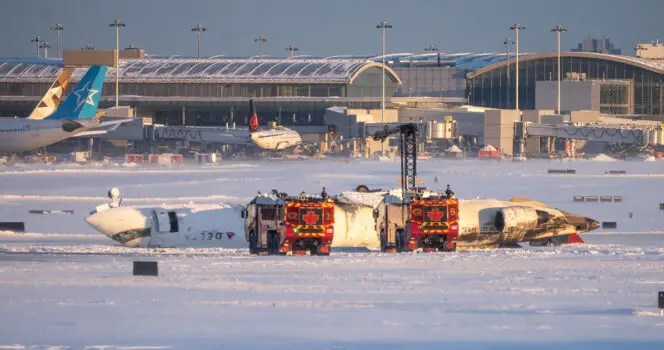At approximately 3:30 p.m. Eastern Time on February 17, Delta Air Lines Flight 4819, a CRJ-900 operated by Endeavor Air, experienced a harrowing incident while attempting to land at Toronto Pearson International Airport. The flight, which departed from Minneapolis, Minnesota, carried 80 people—76 passengers and four crew members—when it unexpectedly flipped upside down during its final approach amid strong winds.
A Miraculous Outcome Amid Chaos
Despite the dramatic turn of events, initial reports confirmed that there were no fatalities—a miracle considering the severity of the crash. However, at least 18 passengers sustained injuries during the accident, with three individuals—one man in his 60s, one woman in her 40s, and one child—suffering critical injuries that necessitated immediate medical attention. Emergency responders quickly transported these individuals to area hospitals, including The Hospital for Sick Children, Sunnybrook Health Sciences Center, and St. Michael’s Hospital.
Toronto Pearson International Airport CEO Deborah Flint expressed relief in an evening statement:
“We are very grateful there was no loss of life and relatively minor injuries.”
Delta Air Lines took to its official Twitter account, Delta News Hub, stating, “Initial reports were that there are no fatalities. Several customers with injuries were transported to area hospitals. Our primary focus is taking care of those impacted.”
Eyewitness Footage Captures the Incident
The incident was captured on video by multiple witnesses, providing a stark visual account of the chaos that ensued. One passenger, Ashley Zook, posted a Snapchat video showing the plane upside down, exclaiming, “My plane crashed. I’m upside down.” Her reaction, punctuated by a startled “What the f**k,” quickly went viral and added to the widespread coverage of the crash.
Audio recordings from the airport’s air traffic control further illuminated the tense moments following the accident. In one recording, an air traffic controller alerted emergency teams by stating, “LifeFlight 1, Medevac, just so you are aware, there are people outside walking around the aircraft there.” Another controller confirmed, “Yeah, we’ve got it—the aircraft is upside down and burning.”
The Role of Weather and Emergency Response
The crash occurred amid reports of strong winds—gusts of up to 40 miles per hour at ground level—which likely contributed to the loss of control during the landing attempt. These high winds, combined with the inherent challenges of operating a small regional aircraft like the CRJ-900, created a hazardous environment that proved too much for the plane to handle.
Emergency crews were dispatched promptly, and their swift response was critical in ensuring the safe evacuation of passengers. Despite the chaotic scene, responders managed to extract everyone from the wreckage, preventing any loss of life and mitigating further injuries.
Investigations and Ongoing Inquiries
Authorities from the Federal Aviation Administration (FAA) have confirmed that an investigation into the incident is underway. Preliminary findings will examine multiple factors, including mechanical issues, pilot error, and the impact of adverse weather conditions. An NTSB investigator is expected to join the inquiry to piece together the sequence of events that led to the crash.
This accident comes in the wake of another devastating incident near Reagan National Airport in Washington, D.C., last month—an accident that resulted in the loss of 67 lives following a midair collision between an American Airlines passenger jet and a U.S. Army Black Hawk helicopter. Although the Delta crash involves a much smaller aircraft, it adds to a concerning series of aviation incidents that have left the public questioning safety standards.
Looking Forward: Safety and Accountability
The tragic Delta Flight 4819 incident underscores the vital importance of continuous improvements in aviation safety. As investigators work to determine the exact causes of the crash, the focus will undoubtedly be on identifying any potential gaps in current safety protocols and ensuring that lessons are learned to prevent similar tragedies in the future.
For the aviation industry, this event serves as a wake-up call—highlighting the need for stringent maintenance practices, rigorous pilot training, and advanced technological solutions to monitor and manage adverse weather conditions during critical phases of flight.
Delta Air Lines Flight 4819’s dramatic crash at Toronto Pearson International Airport, where the aircraft flipped upside down and caught fire during landing, is a sobering reminder of the inherent risks in air travel—especially for smaller, regional aircraft. While it is nothing short of miraculous that all 80 individuals onboard survived, the fact that 18 sustained injuries, including several critically, emphasizes the critical need for enhanced safety measures.
As emergency crews and investigators continue their work, the aviation community and the public will be closely monitoring the outcomes of this investigation. In the meantime, our thoughts are with the injured passengers and their families, and we remain hopeful that this incident will lead to important improvements in aviation safety protocols.
Stay tuned for further updates on this unfolding story as the investigation continues. Share this article to help raise awareness about the importance of robust safety measures in the aviation industry.

